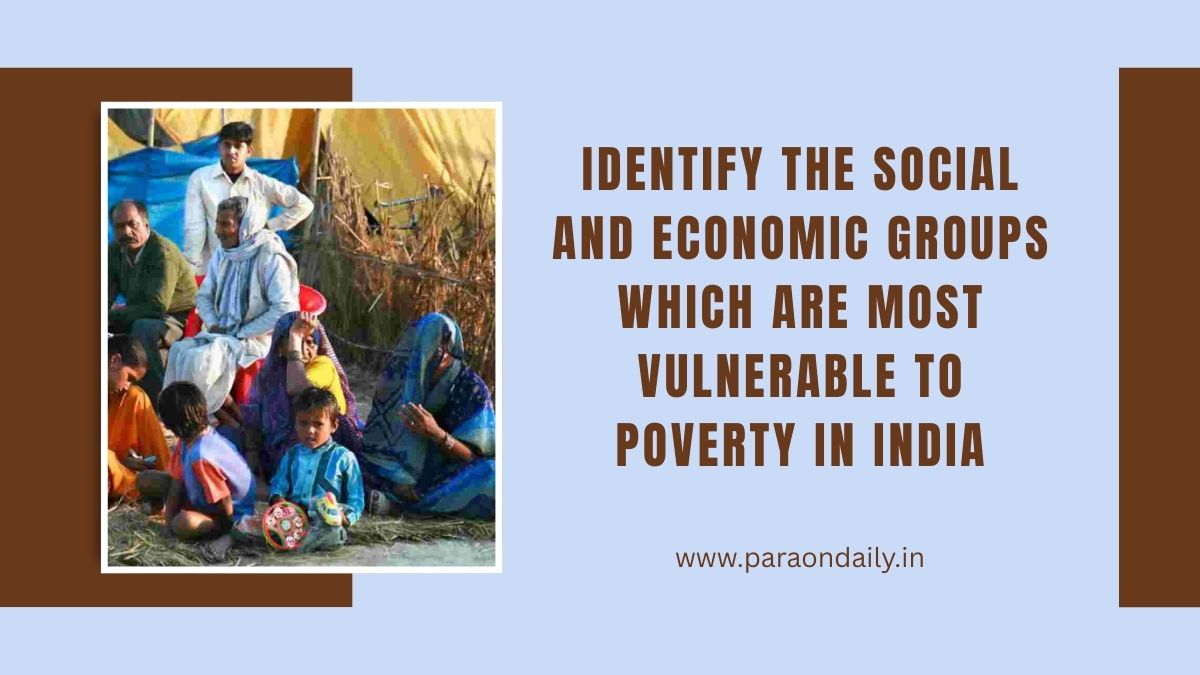Poverty has been one of the most serious challenges in India for many years. Even though the country has made great progress in development, there are still many groups of people who face poverty every day. It is important to identify the social and economic groups which are most vulnerable to poverty in India because this helps the government, organizations, and society to understand who needs the most support.
Poverty is not the same for everyone; some groups suffer more because of their background, education, jobs, or social position. In this blog, we will discuss these groups in simple words.
Understanding Poverty in India
Poverty means a situation where people do not have enough money, resources, or opportunities to meet their basic needs like food, shelter, healthcare, and education. In India, poverty has many causes such as unemployment, lack of land, low wages, and social discrimination. Rural areas are more affected than cities, and within rural areas, some communities are even poorer than others. Recognizing the most vulnerable groups is the first step in reducing poverty.
Also read: Why is Accreditation of Nursing Education Programs Important?
1. Scheduled Castes (SCs)
Scheduled Castes, often called Dalits, are among the most vulnerable groups in India. For centuries, they have faced social discrimination and exclusion. Many of them work in low-paying jobs such as agricultural laborers, sanitation workers, or daily wage earners. Because of this, their income is very limited, and they often do not have access to good education and healthcare. Poverty among Scheduled Castes is very high because of lack of opportunities and long history of inequality.
2. Scheduled Tribes (STs)
Scheduled Tribes, or Adivasis, live mostly in forested and hilly areas. Many of them depend on forest products, farming, or manual labor for survival. They are often cut off from modern facilities like schools, hospitals, and transportation. Because of this isolation, they do not get enough opportunities for jobs or education. Land displacement, mining projects, and lack of proper rights have also made them more vulnerable to poverty.
3. Landless Agricultural Laborers
A large number of people in rural India work on farms but do not own any land. They are called landless agricultural laborers. They depend on seasonal farming for income, which means they only get work during certain times of the year. In times of drought, flood, or crop failure, they lose their only source of livelihood. This makes them one of the poorest groups in the country.
4. Women and Female-Headed Households
Women in India face double challenges—social discrimination and economic inequality. Many women do not get equal wages for the same work, and in some areas, they are not allowed to work outside their homes. Female-headed households, where a woman is the main earner, often suffer from poverty because women get fewer job opportunities and lower pay. Lack of education and healthcare facilities for women also adds to the problem.
5. Rural Poor
Most of India’s poor live in villages. The rural poor include small farmers, landless laborers, and low-income families. Their main problems are low agricultural productivity, lack of modern technology, and dependence on monsoon rains. They also face poor infrastructure like bad roads, no electricity, and lack of clean water. Because of this, poverty is more common in rural India compared to urban areas.
6. Urban Poor
Even though cities have more job opportunities, they also have a large population of poor people. The urban poor live in slums and work as rickshaw pullers, street vendors, construction workers, or domestic helpers. They do not have proper housing, sanitation, or healthcare. Many of them are migrants from villages who come to cities in search of jobs but end up in poverty because of low wages and high living costs.
7. Elderly and Disabled People
Older people who do not have savings or family support are at risk of poverty. They cannot work due to age or health issues, and without pensions or assistance, they struggle to survive. Similarly, disabled individuals often face discrimination and limited job opportunities. Lack of proper support systems makes both these groups highly vulnerable to poverty.
8. Children from Poor Families
Children from poor families suffer the most because they miss out on education, nutrition, and healthcare. Many are forced to work as child laborers to support their families. This cycle of poverty continues from one generation to another because without education, children cannot get good jobs in the future.
9. Minorities and Marginalized Groups
Some minority communities also face poverty because of social discrimination, lack of representation, and fewer opportunities. They often live in backward regions with very little development. Limited access to education and jobs keeps them trapped in poverty.
Why Are These Groups Vulnerable?
These groups are vulnerable to poverty for several reasons:
- Lack of education: Without proper education, it is hard to find good jobs.
- Social discrimination: Certain groups face inequality in society.
- Low wages and unemployment: Many work in unorganized sectors with very little pay.
- Poor healthcare: Illness pushes families into deeper poverty.
- No land or property: Without assets, people cannot improve their financial condition.
Government Efforts to Reduce Poverty
The Indian government has launched many schemes to help vulnerable groups:
- MGNREGA provides guaranteed employment in rural areas.
- Public Distribution System (PDS) ensures cheap food grains.
- Mid-Day Meal Scheme supports poor children in schools.
- Scholarship programs help SCs, STs, and minority students.
- Skill development programs train youth for better jobs.
These efforts have reduced poverty to some extent, but much more still needs to be done.
Importance of Identifying Vulnerable Groups
Identifying the social and economic groups which are most vulnerable to poverty in India is very important because it helps in creating focused policies. Instead of giving equal support to everyone, the government can give more help to those who need it the most. This ensures fairness and faster progress in reducing poverty.
Also read: Families Must Be Notified of an Unauthorized Disclosure of Their Students’ Pii Within How Many Days?
Conclusion
Poverty in India is not the same for all groups. Some sections of society face deeper struggles because of historical, social, or economic disadvantages. When we identify the social and economic groups which are most vulnerable to poverty in India, we see that Scheduled Castes, Scheduled Tribes, women, landless laborers, children, elderly people, rural poor, and urban poor are the most affected. Each of these groups has unique challenges that need special attention.
By providing better education, equal job opportunities, healthcare, and social support, India can reduce poverty and build a more equal society. Understanding who suffers the most is the first step toward creating a fair and prosperous nation.

